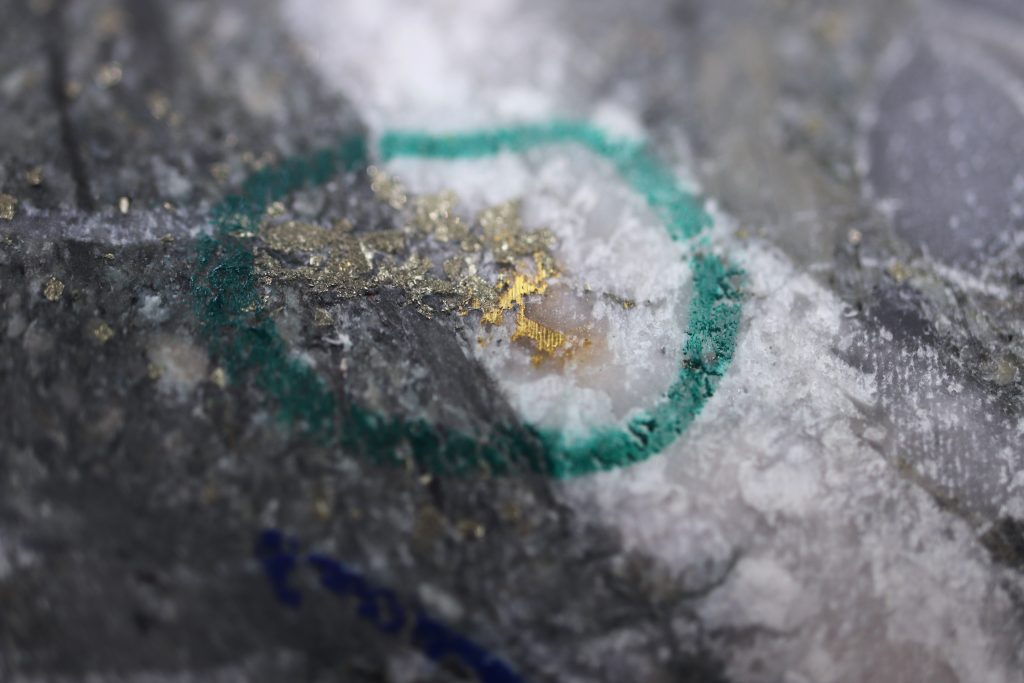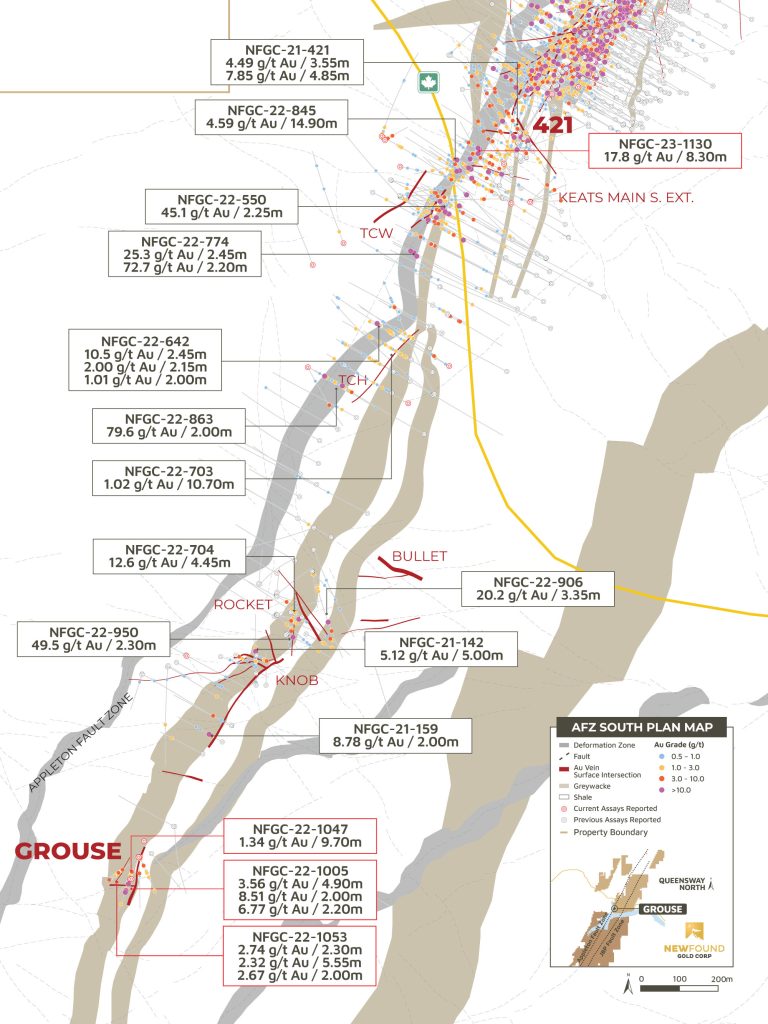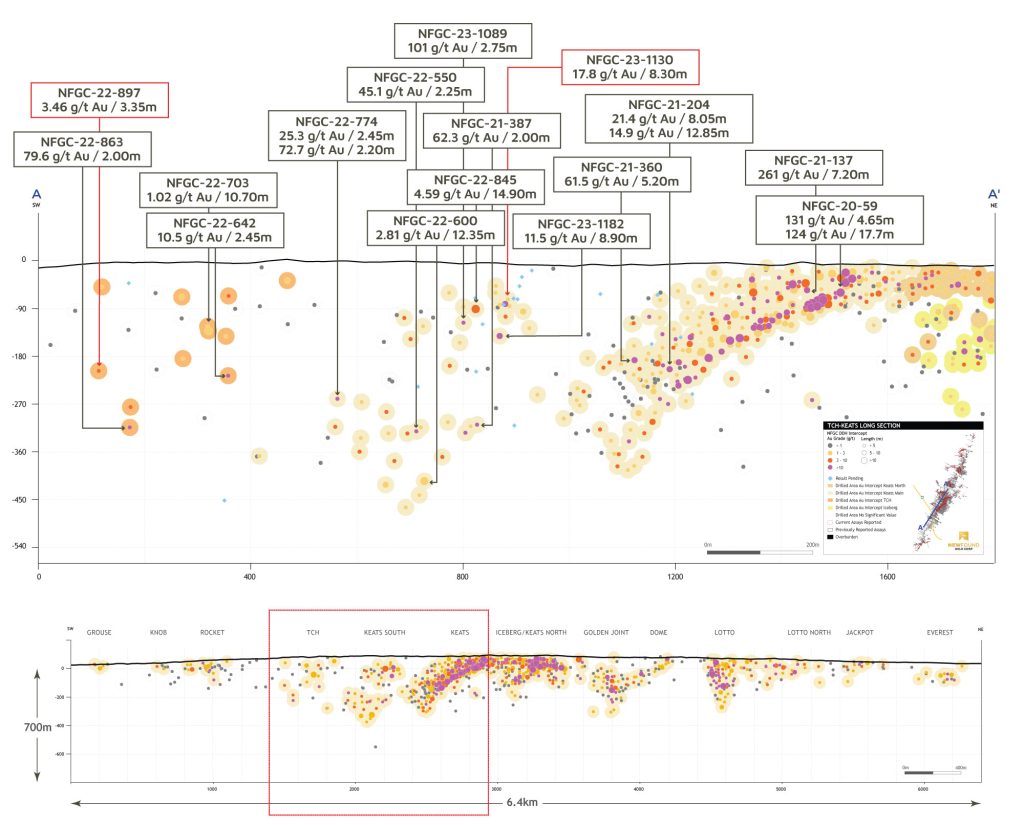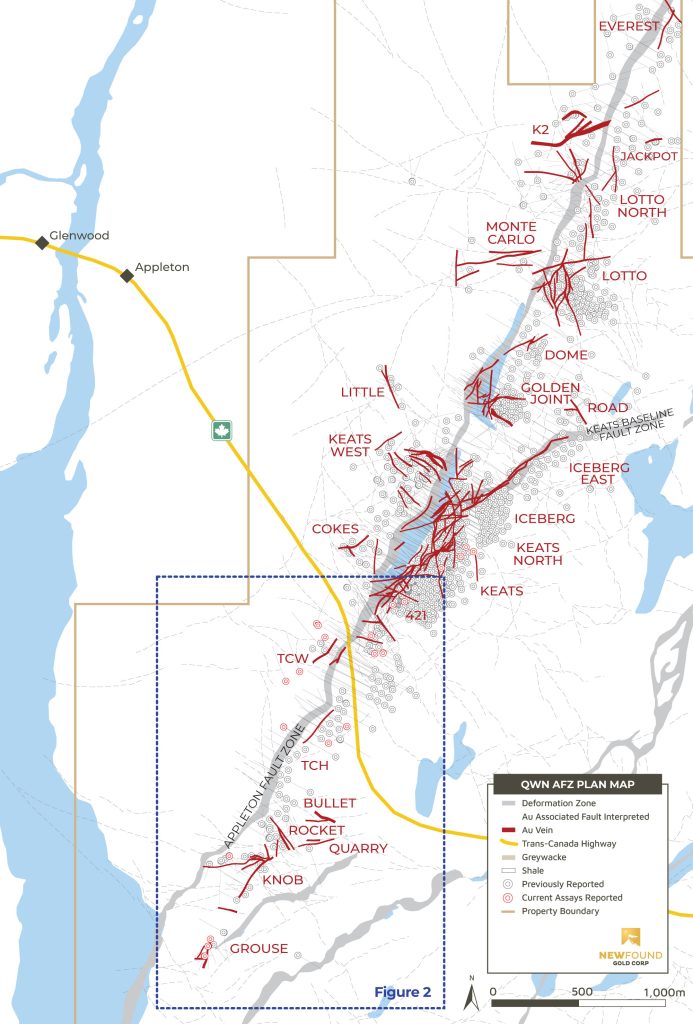
New Found Intercepts 17.8 g/t Au Over 8.3m at 421 Zone, Drills Mineralization 2.7km South of Keats at Grouse Zone
New Found Gold Corp. (TSX-V: NFG) (NYSE-A: NFGC) is pleased to announce the results from 31 diamond drill holes that were completed as part of a follow-up drill program targeting the 421 Zone, a high-grade gold-bearing structure that crosscuts the southern end of the Keats Main Zone, in addition to the results from its first drill program at the historic Grouse Zone, located 2.7km south of Keats, along the highly prospective Appleton Fault Zone. New Found’s 100%-owned Queensway project comprises a 1,662km2 area, accessible via the Trans-Canada Highway, 15km west of Gander, Newfoundland and Labrador.
421 & Grouse Zones Highlights:
| Hole No. | From (m) | To (m) | Interval (m) | Au (g/t) | Zone |
| NFGC-23-11302 | 102.70 | 111.00 | 8.30 | 17.83 | 421 |
| Including | 102.70 | 103.35 | 0.65 | 66.96 | |
| And including | 108.00 | 110.00 | 2.00 | 44.33 | |
| NFGC-22-10051 | 16.60 | 21.50 | 4.90 | 3.56 | Grouse |
| Including | 18.25 | 18.80 | 0.55 | 17.41 | |
| And3 | 43.85 | 45.85 | 2.00 | 8.51 | |
| Including | 43.85 | 44.85 | 1.00 | 17.01 | |
| And3 | 50.40 | 52.60 | 2.20 | 6.77 | |
| Including | 51.20 | 51.75 | 0.55 | 19.14 | |
| NFGC-22-10473 | 61.35 | 71.05 | 9.70 | 1.34 | Grouse |
| NFGC-22-10534 | 74.60 | 76.90 | 2.30 | 2.74 | Grouse |
| And1 | 89.20 | 94.75 | 5.55 | 2.32 | |
| And4 | 136.10 | 138.10 | 2.00 | 2.67 |
Table 1: 421 & Grouse Zones Drilling Highlights
Note that the host structures are interpreted to be steeply dipping and true widths are generally estimated to be 170% to 95%, 240% to 70%, and 310% to 40% of reported intervals. 4True widths are unknown at this time. Infill veining in secondary structures with multiple orientations crosscutting the primary host structures are commonly observed in drill core which could result in additional uncertainty in true width. Composite intervals reported carry a minimum weighted average of 1 g/t Au diluted over a minimum core length of 2m with a maximum of 4m consecutive dilution when above 200m vertical depth and 2m consecutive dilution when below 200m vertical depth. Included high-grade intercepts are reported as any consecutive interval with grades greater than 10 g/t Au. Grades have not been capped in the averaging and intervals are reported as drill thickness.
- The 421 Zone is located at the south end of Keats Main and was initially announced in April 2022. This domain of high-grade gold is controlled by the intersection of a series of south-to-southwest dipping gold-bearing structures with the AFZ and the Keats-Baseline Fault Zone, the fault that hosts Keats Main, Iceberg, and Iceberg East.
- Today’s highlight interval of 17.8 g/t Au over 8.30m in NFGC-23-1130 was intersected 65m up-plunge of previously reported 11.5 g/t Au over 8.90m in NFGC-23-1182 (July 24, 2023), 57m along strike from previously reported 4.59 g/t over 14.90m in NFGC-22-845 (January 18, 2023) and 88m along strike from previously reported 101 g/t Au over 2.75m in NFGC-23-1089 (July 24, 2023). These intervals span a high-grade domain approximately 90m wide with vertical depths ranging from 70m-130m within a broader series of gold-bearing structures that is 160m wide that make up the 421 Zone.
- A further 2km to the south, at the Grouse Zone, New Found’s first pass drilling has identified significant gold mineralization located 300m east of the AFZ. Grouse is a historic showing discovered by trenching and tested by limited drilling in the early 2000s. Akin to the Knob Zone (located 800m north), Grouse consists of massive to stockwork-style quartz veins developed within and around a thick bed of greywacke hosted by an east-west striking fault zone.
- Highlight intervals of 3.56 g/t Au over 4.90m in NFGC-22-1005, 1.34 g/t Au over 9.70m in NFGC-22-1047 and 2.32 g/t Au over 5.55m in NFGC-22-1053, along with the presence of visible gold (Figure 1) and additional significant intervals reported in this press release, span an area 100m along strike, starting near surface and reaching a depth of 80m.
- The Grouse Zone is now the southernmost gold zone drilled at Queensway North. Measuring from Grouse north to the Everest Zone spans an impressive 6.1km of strike where high-grade gold mineralization has been identified through near-surface drilling, indicating that the gold mineralization footprint of the AFZ continues a full 2.7km south of Keats (Figures 1-4).
Melissa Render, VP of Exploration of New Found, stated: “Not only has this additional drilling greatly improved our understanding of the 421 Zone, and more specifically, the controls on the high-grade gold mineralization, it has also added to the list of high-grade results emanating from the highly prospective AFZ corridor. The 421 Zone is an important structure and continued exploration will aim to follow this fault eastward looking for additional interactions with gold-bearing fault zones. At the same time, we are also pleased to announce initial results from the first-ever drilling at the historic Grouse Zone, located a full 2.7km south of Keats. This small first-pass program has identified significant mineralization over 100m of strike starting at surface and is paired with multiple occurrences of visible gold. These results give us confidence that the AFZ gold mineralizing system extends well south of Keats. Only 30,000m of drilling has been conducted by New Found south of the highway, and this is an obvious area that we will be targeting for future exploration.”
Drillhole Details
| Hole No. | From (m) | To (m) | Interval (m) | Au (g/t) | Zone |
| NFGC-21-781* | 102.00 | 105.70 | 3.70 | 2.43 | Keats Main |
| And1* | 112.25 | 115.10 | 2.85 | 14.89 | |
| Including | 114.65 | 115.10 | 0.45 | 87.10 | |
| And1 | 175.00 | 177.60 | 2.60 | 1.05 | Keats FW |
| And2 | 285.00 | 290.60 | 5.60 | 1.40 | |
| NFGC-22-5142* | 149.00 | 151.05 | 2.05 | 2.06 | Keats Main |
| And4 | 206.10 | 208.25 | 2.15 | 2.20 | |
| NFGC-22-912 | No Significant Values | Keats HW | |||
| NFGC-22-927 | No Significant Values | Keats HW | |||
| NFGC-22-982 | No Significant Values | Keats Main | |||
| And2 | 254.20 | 257.65 | 3.45 | 2.32 | Keats FW |
| And2 | 265.80 | 268.25 | 2.45 | 1.18 | |
| And4 | 308.45 | 311.00 | 2.55 | 1.23 | |
| NFGC-22-1007 | No Significant Values | Keats Main | |||
| And4 | 327.40 | 329.65 | 2.25 | 2.00 | Keats N |
| NFGC-23-1106 | No Significant Values | Keats Main | |||
| NFGC-23-11211 | 100.00 | 102.90 | 2.90 | 2.06 | Keats S |
| NFGC-23-11302 | 25.75 | 28.20 | 2.45 | 1.29 | 421 |
| And4 | 38.00 | 40.85 | 2.85 | 1.09 | |
| And4 | 43.10 | 45.60 | 2.50 | 1.16 | |
| And4 | 52.00 | 54.00 | 2.00 | 1.50 | |
| And2 | 102.70 | 111.00 | 8.30 | 17.83 | |
| Including | 102.70 | 103.35 | 0.65 | 66.96 | |
| Including | 108.00 | 110.00 | 2.00 | 44.33 | |
| And2 | 149.80 | 152.00 | 2.20 | 1.85 | |
| NFGC-23-15401 | 95.00 | 98.00 | 3.00 | 2.01 | 421 |
| NFGC-23-1589 | No Significant Values | 421 | |||
| NFGC-23-15981 | 104.15 | 106.60 | 2.45 | 1.25 | 421 |
| NFGC-23-16041 | 112.00 | 114.35 | 2.35 | 2.13 | 421 |
| NFGC-22-7774 | 80.00 | 82.00 | 2.00 | 3.73 | TCH |
| NFGC-22-841 | No Significant Values | TCH | |||
| NFGC-22-8974 | 221.00 | 224.35 | 3.35 | 3.46 | TCH |
| NFGC-23-1104 | No Significant Values | TCW | |||
| And | No Significant Values | Keats S | |||
| NFGC-23-11372 | 64.75 | 70.30 | 5.55 | 1.05 | TCH |
| And3 | 287.25 | 289.85 | 2.60 | 3.58 | |
| NFGC-23-11501 | 31.95 | 34.45 | 2.50 | 1.69 | TCH |
| NFGC-23-11661 | 16.70 | 18.70 | 2.00 | 2.35 | TCH |
| And1 | 40.75 | 48.00 | 7.25 | 1.05 | |
| NFGC-23-1172 | No Significant Values | TCW | |||
| NFGC-23-1185 | No Significant Values | TCW | |||
| NFGC-22-925 | No Significant Values | Knob | |||
| NFGC-22-10051 | 16.60 | 21.50 | 4.90 | 3.56 | Grouse |
| Including | 18.25 | 18.80 | 0.55 | 17.41 | |
| And3 | 43.85 | 45.85 | 2.00 | 8.51 | |
| Including | 43.85 | 44.85 | 1.00 | 17.01 | |
| And3 | 50.40 | 52.60 | 2.20 | 6.77 | |
| Including | 51.20 | 51.75 | 0.55 | 19.14 | |
| NFGC-22-1011 | No Significant Values | Grouse | |||
| NFGC-22-1016 | No Significant Values | Grouse | |||
| NFGC-22-1022 | No Significant Values | Grouse | |||
| NFGC-22-10354 | 56.70 | 62.00 | 5.30 | 1.45 | Knob |
| NFGC-22-10473 | 53.90 | 56.55 | 2.65 | 1.86 | Grouse |
| And3 | 61.35 | 71.05 | 9.70 | 1.34 | |
| NFGC-22-10534 | 74.60 | 76.90 | 2.30 | 2.74 | Grouse |
| And1 | 80.30 | 82.60 | 2.30 | 1.08 | |
| And1 | 89.20 | 94.75 | 5.55 | 2.32 | |
| And4 | 99.30 | 101.80 | 2.50 | 1.32 | |
| And4 | 136.10 | 138.10 | 2.00 | 2.67 | |
| NFGC-22-1066 | No Significant Values | Grouse | |||
Table 2: Summary of composite results reported in this press release for Keats FW, Keats HW, 421, TCW, TCH, Knob and Grouse zones.
Note that the host structures are interpreted to be steeply dipping and true widths are generally estimated to be 170% to 95%, 240% to 70%, and 310% to 40% of reported intervals. 4True widths are unknown at this time. Infill veining in secondary structures with multiple orientations crosscutting the primary host structures are commonly observed in drill core which could result in additional uncertainty in true width. Composite intervals reported carry a minimum weighted average of 1 g/t Au diluted over a minimum core length of 2m with a maximum of 4m consecutive dilution when above 200m vertical depth and 2m consecutive dilution when below 200m vertical depth. Included high-grade intercepts are reported as any consecutive interval with grades greater than 10 g/t Au. Grades have not been capped in the averaging and intervals are reported as drill thickness. *Previously reported interval.
| Hole No. | Azimuth (°) | Dip (°) | Length (m) | UTM E | UTM N | Prospect |
| NFGC-21-78 | 300 | -45 | 720 | 658183 | 5427426 | Keats |
| NFGC-22-514 | 295 | -45.5 | 387 | 658295 | 5427493 | Keats |
| NFGC-22-777 | 304 | -54 | 488 | 657637 | 5426511 | TCH |
| NFGC-22-841 | 300 | -45 | 347 | 657531 | 5426415 | TCH |
| NFGC-22-897 | 150 | -60 | 350 | 657272 | 5426508 | TCH |
| NFGC-22-912 | 35 | -45 | 144 | 657902 | 5427213 | Keats |
| NFGC-22-925 | 120 | -45 | 236 | 656959 | 5425763 | Knob |
| NFGC-22-927 | 30 | -45 | 138 | 657970 | 5427231 | Keats |
| NFGC-22-982 | 300 | -45 | 395 | 658325 | 5427546 | Keats |
| NFGC-22-1005 | 200 | -45 | 128 | 656814 | 5425185 | Grouse |
| NFGC-22-1007 | 300 | -45 | 434 | 658369 | 5427521 | Keats North |
| NFGC-22-1011 | 85 | -45 | 68 | 656817 | 5425186 | Grouse |
| NFGC-22-1016 | 220 | -60 | 110 | 656814 | 5425186 | Grouse |
| NFGC-22-1022 | 0 | -90 | 68 | 656839 | 5425243 | Grouse |
| NFGC-22-1035 | 180 | -45 | 188 | 656836 | 5425243 | Grouse |
| NFGC-22-1047 | 204 | -42 | 125 | 656836 | 5425243 | Grouse |
| NFGC-22-1053 | 230 | -45 | 143 | 656835 | 5425243 | Grouse |
| NFGC-22-1066 | 0 | -90 | 65 | 656850 | 5425284 | Grouse |
| NFGC-23-1104 | 100 | -45 | 242 | 657511 | 5427026 | TCH |
| NFGC-23-1106 | 300 | -45 | 359 | 657797 | 5426931 | Keats |
| NFGC-23-1121 | 300 | -53 | 203 | 657798 | 5426931 | Keats |
| NFGC-23-1130 | 300 | -45 | 203 | 657778 | 5427033 | Keats |
| NFGC-23-1137 | 120 | -45 | 314 | 657467 | 5427101 | TCH |
| NFGC-23-1150 | 20 | -45 | 341 | 657463 | 5427104 | TCH |
| NFGC-23-1166 | 60 | -60 | 140 | 657471 | 5427094 | TCH |
| NFGC-23-1172 | 340 | -45 | 320 | 657285 | 5426772 | TCH |
| NFGC-23-1185 | 340 | -45 | 350 | 657364 | 5426828 | TCH |
| NFGC-23-1540 | 64 | -45 | 146 | 657847 | 5426936 | Keats |
| NFGC-23-1589 | 73 | -60 | 143 | 657846 | 5426934 | Keats |
| NFGC-23-1598 | 48 | -54 | 161 | 657847 | 5426934 | Keats |
| NFGC-23-1604 | 87 | -48 | 134 | 657847 | 5426934 | Keats |
Table 3: Details of drill holes reported in this press release
Queensway 500,000m Drill Program Update
The Company is currently undertaking a 500,000m drill program at Queensway and approximately 37,700m of core is currently pending assay results.
Sampling, Sub-sampling, and Laboratory
All drilling recovers HQ core. Drill core is split in half using a diamond saw or a hydraulic splitter for rare intersections with incompetent core.
A geologist examines the drill core and marks out the intervals to be sampled and the cutting line. Sample lengths are mostly 1.0 metre and adjusted to respect lithological and/or mineralogical contacts and isolate narrow (<1.0m) veins or other structures that may yield higher grades.
Technicians saw the core along the defined cutting line. One-half of the core is kept as a witness sample and the other half is submitted for analysis. Individual sample bags are sealed and placed into totes, which are then sealed and marked with the contents.
New Found has submitted samples for gold determination by fire assay to ALS Canada Ltd. (“ALS”) and by photon assay to MSALABS (“MSA”) since June 2022. ALS and MSA operate under a commercial contract with New Found.
Drill core samples are shipped to ALS for sample preparation in Sudbury, Ontario, Thunder Bay, Ontario, or Moncton, New Brunswick. ALS is an ISO-17025 accredited laboratory for the fire assay method.
Drill core samples are also submitted to MSA in Val-d’Or, Quebec. MSA operates numerous laboratories worldwide and maintains ISO-17025 accreditation for many metal determination methods. Accreditation of the photon assay method at the MSA Val D’Or laboratory is in progress.
At ALS, the entire sample is crushed to approximately 70% passing 2mm. A 3,000-g split is pulverized. “Routine” samples do not have visible gold identified and are not within a mineralized zone. Routine samples are assayed for gold by 30-g fire assay with an inductively-couple plasma spectrometry (ICP) finish. If the initial 30-g fire assay gold result is over 1 g/t, the remainder of the 3,000-g split is screened at 106 microns for screened metallics assay. For the screened metallics assay, the entire coarse fraction (sized greater than 106 microns) is fire assayed and two splits of the fine fraction (sized less than 106 microns) are fire assayed. The three assays are combined on a weight-averaged basis. Samples that have VG identified or fall within a mineralized interval are automatically submitted for screened metallic assay for gold.
At MSA, the entire sample is crushed to approximately 70% passing 2mm. For “routine” samples that do not have VG identified and are not within a mineralized zone, the samples are riffle split to fill two 450g jars for photon assay. The assays reported from both jars are combined on a weight-averaged basis. If one of the jars assays greater than 1 g/t, the remaining crushed material is weighed into multiple jars and are submitted for photon assay.
For samples that have VG identified or are within a mineralized zone, the entire crushed sample is weighed into multiple jars and are submitted for photon assay. The assays from all jars are combined on a weight-averaged basis.
All samples prepared at ALS or MSA are also analyzed for a multi-element ICP package (ALS method code ME-ICP61) at ALS Vancouver.
Drill program design, Quality Assurance/Quality Control and interpretation of results are performed by qualified persons employing a rigorous Quality Assurance/Quality Control program consistent with industry best practices. Standards and blanks account for a minimum of 10% of the samples in addition to the laboratory’s internal quality assurance programs.
Quality Control data are evaluated on receipt from the laboratories for failures. Appropriate action is taken if assay results for standards and blanks fall outside allowed tolerances. All results stated have passed New Found’s quality control protocols.
New Found’s quality control program also includes submission of the second half of the core for approximately 2% of the drilled intervals. In addition, approximately 1% of sample pulps for mineralized samples are submitted for re-analysis to a second ISO-accredited laboratory for check assays.
The Company does not recognize any factors of drilling, sampling or recovery that could materially affect the accuracy or reliability of the assay data disclosed.
The assay data disclosed in this press release have been verified by the Company’s Qualified Person against the original assay certificates.
The Company notes that it has not completed any economic evaluations of its Queensway Project and that the Queensway Project does not have any resources or reserves.
Qualified Person
The scientific and technical information disclosed in this press release was reviewed and approved by Greg Matheson, P. Geo., Chief Operating Officer, and a Qualified Person as defined under National Instrument 43-101. Mr. Matheson consents to the publication of this press release dated September 20, 2023, by New Found. Mr. Matheson certifies that this press release fairly and accurately represents the scientific and technical information that forms the basis for this press release.
About New Found Gold Corp.
New Found holds a 100% interest in the Queensway Project, located 15km west of Gander, Newfoundland and Labrador, and just 18km from Gander International Airport. The project is intersected by the Trans-Canada Highway and has logging roads crosscutting the project, high voltage electric power lines running through the project area, and easy access to a highly skilled workforce. The Company is currently undertaking a 500,000m drill program at Queensway and is well funded for this program with cash and marketable securities of approximately $39.5 million as of September 2023.
Figure 1: Photo of mineralization at ~51.2m in NFGC-22-1005 ^Note that this photo is not intended to be representative of gold mineralization in NFGC-22-1005. (Photo: Business Wire)
Figure 2. 421 – Grouse plan view map (Graphic: Business Wire)
Figure 3. Iceberg, Keats Main, 421, Keats South, and TCH zones long section (looking northwest) (Graphic: Business Wire)
Figure 4. Grouse – Everest plan view map (Graphic: Business Wire)
MORE or "UNCATEGORIZED"
Kuya Silver Confirms High-Grade Silver-Gold Vein Mineralization at Umm-Hadid with Initial Drill Results up to 1483.9 g/t AgEq over 2 Metres
Kuya Silver Corporation (CSE: KUYA) (OTCQB: KUYAF) (FSE: 6MR1) is... READ MORE
First Phosphate Closes Final Tranche of Oversubscribed Private Placement
First Phosphate Corp. (CSE: PHOS) (OTCQX: FRSPF) (FSE: KD0) is... READ MORE
GFG Receives Final Payment from the Sale of its Rattlesnake Hills Gold Project
GFG Resources Inc. (TSX-V: GFG) (OTCQB: GFGSF) announces that i... READ MORE
Goliath Receives $1,730,882 Through Warrant Exercises, Inclusive Of Crescat Capital A Longtime Strategic And Cornerstone Shareholder
Goliath Resources Limited (TSX-V: GOT) (OTCQB: GOTRF) (FSE: B4IF)... READ MORE
Robex Pours First Gold at Kiniéro on Schedule and Budget
Highlights: Gold bar weighing 2.64 kilograms (85 oz) poured in th... READ MORE

















